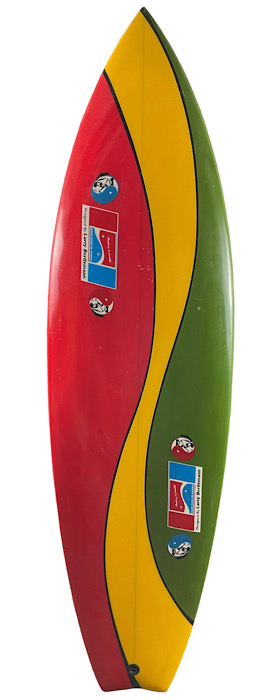Larry Bertlemann shaped twin-fin surfboard (early 2000s)
by
Comment below for waitlist | Hawaii | Worldwide Shipping | Comment below or call 1-800-210-6714
Larry Bertlemann shaped twin-fin surfboard made in the early 2000s. Featuring signature swirl airbrush design with irie color scheme. Larry Bertlemann’s catchphrase “Anything is Possible” laminates on both sides with glass-on twin fins. 6’0 swallow tail. Bertlemann is a revered Hawaiian surfer and innovator of aerial surfing, dubbed ”the Rubberman” for his radical maneuvering on the wave. “He didn’t invent the shortboard, he just showed us how to ride it”. No one had a greater influence on the way people surf waves than Larry Bertlemann. Ride or display this classic Larry Bertlemann shaped twin-fin surfboard.
If you have questions about this Larry Bertlemann twin fin surfboard scroll down to leave a comment or call us toll-free at 1-800-210-6714
History of Larry Bertlemann Surfboards
One of the most exposed professional surfers, shortboard pioneer Larry Bertlemann, can be easily credited with the vast majority of contributions to the evolution of the sport. His style was the exact opposite of the expressing carving of the 1960s and 1970s. He gained the nickname “Rubberman”, after a definite, powerful spring in his surfing style. Larry Bertlemann was the one to deny current values and ride waves top to bottom with sharp turns in the pocket.
Bertlemann was born on August 7th, 1955 in Hilo, Hawaii. His adventure with surfing began at 11 when his family moved to Honolulu. From that moment on, he progressed quickly and always aimed high. Soon the young Larry was surfing waves from Ala Moana bowls on the South Shore to the heavier waves on the North Shore, which immediately became the development grounds of modern jazzed up surfing. He started working with famous shaper Ben Aipa to develop and refine surfboards that allowed for his innovative approach. Ben Aipa was his mentor at the time, and together they redefined the standard for performance equipment. Aipa’s swallowtail and stinger designs of the mid-70s facilitated some of Bertlemann’s best surfing.
On a personal level, Aipa discouraged Bertlemann from pursuing a professional competitive career in surfing. Despite Aipa’s advice and his own distaste for competition, Bertlemann turned pro in the early 70s. Without conforming to the restraints of competition, he finished third in the 1972 World Contest in San Diego. A year later, he won the U.S. Surfing Championship. Although he became one of the highest-paid pros of the time, he experienced only marginal competitive success, and stayed in the top 16 in both 1976 and 1979. His style was so different from the norms that competition judges rarely understood how to score his maneuvers. “I surfed for myself and the public, not for five judges,” claims Larry- “How do you score a maneuver you’ve never seen before?” Thanks to Aipa’s wide, short (less than 6-foot) swallowtail and stinger designs, Larry had total freedom of movement. Bertlemann could do all the spontaneous maneuvers from low gravity cutbacks, 360s to switchfoot antics, and they remained functional. He was also interested in design. Bertlemann shaped his first board inside a friend’s house. After watching Sparky (from the Sparky’s Surf Shop) and working with Aipa, he began shaping regularly, cooperating with Town and Country, George Downing and others. Bertlemann also helped in the renaissance of ultra-short twin-fins around 1980.
His dominant presence in the media overshadowed Larry Bertlemann’s competitive career. He was featured on a record nine magazine covers, and he was one of the first professionals to land a deal with significant corporate sponsors like Pepsi, OP, Toyota, and United Airlines. He even starred a role in Hal Jepsen’s 1975 film Super Session. His hyper-exposed surfing wasn’t the sole thing that he used to stay in the public eye. Frequently surfing in color-coordinated outfits along with his characteristic Afro, Bertlemann made sure the cameras followed him wherever he went. He even surfed Pipeline in a custom bell-bottom styled wetsuit. Being in media’s spotlight made him one of Hawaii’s great ambassadors of the 1970s. Larry really revolutionized the surfing world- it was the first time the surfing lifestyle was available to non-surfers across the planet. Pictures of Bertlemann spread across the globe, and in a short time he grew into the very well known icon of Hawaiian surfing.
Finally, around 1998, his desire for speed and adventure got the better of him. The years of physical abuse from skateboarding, surfing and motorcycle and truck racing resulted in two degenerating discs, leaving the right side of his body paralyzed. He has since regained motion through surgery and therapy, but he is far from his old self. After coming back to Oahu, he began shaping as much as his body would allow. In the summer of 2001, he was arrested on robbery and weapons charges and spent the next years in jail, following a popular “Free Bert” campaign. Upon his release, Bertlemann began making surfboards again, even forming mass-production deals with Rebel Boards and Santa Cruz. In terms of numbers, his greatest influence was amusingly on skateboarding. Award-winning documentary Dogtown and Z-Boys, relates to the rise of vert skating begins with names like Alva, Peralta and Adams trying to take Larry’s approach on a wave to streets and parks; they even call their slide-out turns, “Berts.” Now Larry Bertlemann surfs rather infrequently, but people in and out of the surfing world will never forget the significant contributions of this Hawaiian legend.





